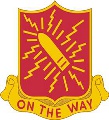



Post-World War II
1946-2007
1946-2007
(c) 152nd Field Artillery Association, 2009
152nd Field Artillery Association
Beginning in 1946, the National Guard began the process of
reconstitution. In Maine, the old 152nd FA Regimental HQ
and the Second Battalion were not reconstituted, leaving
only the First Battalion. Federal recognition came in 1947
along with some changes to stationing: Headquarters
moved from Houlton to Caribou, B Battery from Caribou to
Houlton, C Battery from Ft. Fairfield to Ft. Kent, and the new
Service Battery took over Fort Fairfield.
Lieutenant Colonel Herbert M. Brown was the first battalion
commander of the newly reorganized battalion. LTC Brown
had been the battalion's Plans and Training Officer and a
lieutenant when the battalion mobilized in 1941; by 1943 he
commanded the 739th Field Artillery battalion and fought the
battalion across Europe to much acclaim.
Two giants of the battalion, Sergeant Major Bouchard
and Lieutenant Colonel Doody
In the 1950s, all the units of the battalion moved into newly built armories.
The battalion briefly converted to Air Defense and fielded the Twin 40
"Duster" self-propelled anti-aircraft guns, and Service Battery got the chance
to be a line battery for a couple of years.
In the 60s the battalion fielded self-propelled howitzers (can anyone provide
details?). B Battery fired a 21-gun salute in honor of President Kennedy on the
day of his funeral.
In 1971 the battalion made history by going to Canada to conduct annual
training, beginning a 35-year fruitful relationship with Canadian Forces Base
Gagetown.
In the 1980s the battalion sent B Battery to Camp Ripley Minnesota for annual
training, the entire battalion to Fort A.P. Hill in 1985, won the Eisenhower
Trophy at least twice, and fielded the new M198 155mm Howitzers. The
battalion also began holding an annual "officers' party," which transitioned into
the St. Barbara's celebration.
The Artillery Punch Ceremony at a Saint Barbara's celebration in the 1990s.
Among the many tragedies surrounding the
deactivation of the battalion is the end of the
opportunity to recognize so many great artillerymen
through the Honorable Order of Saint Barbara, and
also great supporters of the battalion through the
Molly Pitcher Award. See the roster of St. Barbara
and Molly Pitcher recipients.
In the mid-1990s the battalion expanded out of
Aroostook County for the first time since the early
70s, when there was a detachment of B Battery in
Millinocket. Alpha Battery moved their flag to
Waterville and the Presque Isle armory became a
detachment of C Battery; also Calais became a
detachment of B Battery.
Battalion soldiers work on Bangor Hydro's Washington County powerline
after the Ice Storm of January 1998.
The late-90's saw three State mobilizations. Two
were to assist in searches for lost hunters in the
Ashland and Danforth areas. The other was in
response to the ice storms of January 1998, known
as Operation Ice Guard.
In 2000 the battalion travelled to Dugway Proving Grounds, Utah for
annual training. The next year we fielded the new Advanced Field
Artillery Tactical Data System (AFATDS), among the first battalions in
the Army, active or Guard, to field the version that replaced the
Battery Computer System (BCS) at the battery fire direction centers.
In 2004, as significant portions of the battalion began deploying in
support of the Global War on Terror, the battalion deployed to
Canadian Forces Base Val Cartier, outside of Quebec City, for
Annual Training. In 2005 the battalion was back to Gagetown but
without any guns, as we tailored training towards non-artillery tasks
that our soldiers were performing overseas.
In 2006 we executed our last Annual Training at CFB Gagetown, and
fired our guns for the last time.















